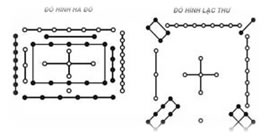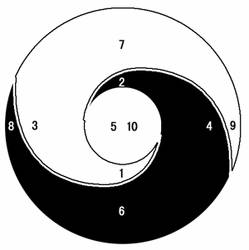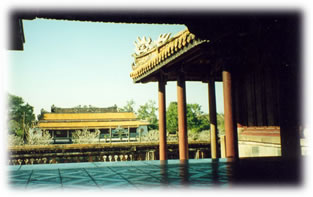Yin and Yang numbers (Con số Âm Dương)
One is accustomed to say in Vietnamese: sống chết đều có số cả (Everyone has his D day for life and death). Ði buôn có số, ăn cỗ có phần (One has his vocation in trade as one has his part in feast). In daily life, everyone a his size for his clothing and his shoes. Contrary to the Chinese, the Vietnamese emphasize odd numbers (số dương) rather than even numbers (sô’ âm).
One frequently finds the use of even numbers in the Vietnamese phrases: ba mặt một lời (One needs to be in front of someone with the presence of a witness), ba hồn bảy vía ( three souls and 7 vital supports for men i.e one is terrified), Ba chìm bảy nổi chín lênh đênh ( very hectic), năm thê bảy thiếp ( to have 5 spouses and 7 concubines i.e. to have many women ), năm lần bảy lượt ( many times), năm cha ba mẹ ( heterogenuos), ba chóp bảy nhoáng ( with precipitation and no care ), Môt lời nói dối , sám hối 7 ngày (A speech deceitful amounts to seven days of repentance), Một câu nhịn chín câu lành (To avoid an offensive sentence is having kind sentences ) etc …or that of integral multiples of the number 9:18 (9×2) đời Hùng Vương ( 18 legendary kings Hùng Vương ), 27 (9×3) đại tang 3 năm (27 tháng)(or a beareavement endured on three years or 27 months only), 36 (9×4) phố phường Hànội (Hànội with 36 neighbourhoods) etc …One don’t forget to mention the numbers 5 and 9, having each of them a role very important. The figure 5 is the number the most mysterious because all starts from this number. Heaven and Earth have the five elements or agents giving birth to thousand things and objects. It is placed in the center of the River map and Writings of Luo which are the basis for the mutation of five elements (Thủy, Hỏa, Mộc, Kim, Thổ)( Water, Fire, Wood, Metal and Earth). It is associated to the element Earth in the central position that the peasant needs to known for the management of cardinal points. This goes to the man to have the centre in the management of things and species and four cardinals. That is why, in the feudal society, this place is reserved to the king because it is he who has govern the people. Consequently, the number 5 belonged to him as well as the yellow colour symbolizing the Earth. This explains the colour choosen by Vietnamese and Chinese emperors for their clothes.
Ho Tou Lo Chou
(Hà Đồ Lạc Thư)

In the addition to the centre occupied by man, an symbolic animal is associated to the each of four cardinal points: the North by the turtle, the South by the phoenix, the West by the dragon and the East by the tiger. One is’nt surprised to see at least in this attribution the presence of three animals living in the region where the agricultural life plays a notable role and water is vital. It is the land of Bai Yue group. Even the dragon very mean in others cultures becomes a kind and noble animal imagined by peaceful peoples Bai Yue. The number 5 is yet known under the name « Tham Thiên Lưỡng Đia » (or three Heaven two Earth or 3 Yang 2 Yin) in the Yin and Yang theory because the acquisition of the number 5 coming from the union of numbers 3 and 2 corresponds better to the reasonable percentage of Yin and Yang than that of the association of numbers 4 and 1. In this latter, the number Yang 1 very dominated by the number 4. It is’nt the case of the union of the numbers 3 and 2 because the number Yang 3 slightly overpowers the number Yin 2. This encourages the universe development in an almost perfect harmony. In ancient times, the fifth day, the fourteen en day (1+4=5) and the twenty-third (2+3=5) day in the month were reserved for the way out of the king. It is’nt allowed to subjects for trading during his travel and disturbing his walk. It is perhaps the reason for which a great number of the Vietnamese continue to avoid these days for the home construction, the trip and major purchases. One is accustomed to say:
Chớ đi ngày bảy chớ về ngày ba
Mồng năm, mười bốn hai ba
Đi chơi cũng lỗ nữa là đi buôn
Mồng năm mười bốn hai ba
Trồng cây cây đỗ, làm nhà nhà xiêu
You avoid going out the 7th day and coming back the 3th in the month. For the 15th, 14th and 23th days in the month, you will be losing if you go out or you trade. Likewise, you will see the failing tree or the tilting of your home if you make the planting tree or the house construction.
The number 5 is frequently mentioned in the Vietnamese culinary art. The most typical sauce remains the fish brine (nước mắm). In the preparation of this national sauce, one mentiones the presence of 5 flavours classified according to the 5 elements of Yin and Yang:mặn ( salty ) with the fish juice (nước mắm), đắng (bitter) with the lemon zest (vỏ chanh), chua (acidulous) with the lemon juice, cay (spicy) with pigments crushed in powder or chopped in strips and ngọt (sweet ) with sugar in powder. These 5 flavours ( mặn, đắng, chua, cay, ngọt ) combined and found in the Vietnamese national sauce correspond to 5 elements defined in the Yin and Yang theory (Thủy, Hỏa , Mộc , Kim Thổ ) ( Water, Fire, Wood, Metal and Earth ).
Likewise, one rediscovers these 5 flavours in the bittersweet soup (canch chua) prepared from fish: acidulous with tamarin seeds or vinegar, sweet with slices of ananas, spicy with pigments chopped in strips, salty with fish juice and bitter with some okras (đậu bắp) or flowers of « fayotier in French » (bông so đũa). When the soup is served, one will add some fragrant herbs like the panicaut (ngò gai), rau om (herb having the flavor of coriander with a lemony taste in addition). It is a characteristic trait of the bittersweet soup of Sud Vietnam which is different from those found in others regions of Vietnam.
One cannot forget to mentione the sweet rice cake that the Proto-Vietnamese had succeeded to bequeath to descendants over millennia of their civilization. This sweet rice cake is the intangible proof of Yin and Yang theory and 5 elements belonging to Bai Yue group (Hundred Yue), the Proto-Vietnamese of which formed part because there is the generation cycle (Ngũ hành tương sinh) in its composition.
(Fire->Earth->Metal->Water->Wood)
Inside the cake, one finds a piece of porkmeat in red color ( Fire ) around which there is a kind of paste made with broad beans in yellow color ( Earth ). The whole thing is wrapped by the sticky rice in white color ( Metal ) to be cooked with boiling water ( Water ) before having a green colouring on its surface thanks to the latanier leaves (Wood).
An other cake is not missing th weddings. This is the cake susê or phu thê (husband-spouse) having inside a round form and enveloped by banana leaves (green colour) in order to give it the well-tied cube appearance with a red ribbon (red color). The circle is thus placed within the square (Dương trong âm)(Yang in Yin). This cake is made from tapioca flour, perfumed in pandan and strewn with black sesame seeds (black color). One finds in the hearth of this cake a paste made of steamed soybeans (yellow color) and jam of lotus seeds and grated coconut.(white color). This paste is very similar to the frangipane found in « galettes des rois ». Its sticky texture reminds the link that one can represent in the union. This cake is the symbol of the perfection in conjugal love and loyalty responding the perfect agreement with the Heaven and the Earth and 5 elements symbolized by 5 colors (red, green, black, yellow and white).
This cake is related by the following tale: in the past, there was a merchant engaged in debauchery and doing not like to go home although before his departure, his spouse gave him the cake susê and promised to remain cordial and sweet like the cake. That is why, when she has heard this story, she did send others cakes phu thê accompagnied by two following verses:
Từ ngày chàng bước xuống ghe
Sóng bao nhiêu đợt bánh phu thê rầu bấy nhiêu
Since your departure, waves were encountered by your boat as much as afflictions were known by the cake susê
Lầu Ngũ Phụng
In architecture, the number 5 is not forgetten either. It is the case of Ngọ Môn gate (noon gate) in the forbidden city (Huế). This gate is a powerful masonry foundation drilled with five passages and surmonted by an elegant wooden structure with two levels, the Belvedere of five Phoenixes (Lầu Ngủ Phụng). Viewed from the sky, this latter with two additional wings, seems to form five phoenix in flight with intertwined beaks. This belvedere possesses 100 wood columns(gỗ lim)(ironwood) painted and tinted in yellow for allowing to carry its nine roofs. This number 100 was well examinated by Vietnamese specialists. According to renowned archeologist Phan Thuận An, it exactly corresponds to the total number obtained by adding two numbers found respectively in the River map (Hà Đồ) and Writings of Luo (Lạc thư cửu tinh đồ) symbolizing the perfect harmony of the union Yin and Yang. It is not the Liễu Thượng Văn advice. According to this latter, this represents the strength of 100 families or people (bách tính) and reflects the notion dân vi bản (consider people as basis) in the Nguyễn dynasty’s governance. The roof of the central pavilion is covered by yellow tiles « lưu ly », the rest being with blue tiles « lưu ly ». Being just in the middle, the main gate (or noon gate) is reserved to the king and paved with stones « Thanh » tinted in yellow color. From both sides, one finds left and right doors (Tả, Hữu, Giáp Môn) reserved to civilian and military mandarins. Then two others lateral gates Tả Dịch Môn và Hữu Dịch Môn are intended to soldiers and horses. One is accustomed to say in Vietnamese:

Ngọ Môn năm cửa chín lầu
Một lầu vàng, tám lầu xanh, ba cửa thẳng, hai cửa quanh »
The noon gate possesses 5 passages and 9 roofs the one of which is varnished in yellow and the 8 others in blue. There are three main doors and two side entries.
In the east and west of the citadel, ones finds Humanty and Virtue gates which are reserved respectively for men and women.
The number 9 is a Yang number (or odd number). It representes the Yang strength at the maximum. It is difficult to reach it. That is why, in the past, the emperor often uses for showing his power and supremacy. He climbs 9 stairs symbolizing the ascent of sacred mountain in which there was his throne. It is said that the forbidden city like that of Pékin possessed 9999 rooms. It is useful to recall that the forbidden city of Pékin was supervised by Nguyễn An, a Vietnamese exiled still young at the time of the Ming. As his palaces, the emperor turns towards the South in Yang energy in order to receive the vital breath of Sky because he is the Heaven son. In Vietnam, one finds nine dynastic urns of Huế citadel, nine branchs of Mekon river, nine roofs of Belvedere of five Phoenixes etc … In the tale intituled « The God of Mountains and the God of Rivers « (Sơn Tinh Thủy Tinh) », 18th (2×9) Hùng Vương king, proposed for the dowry marriage of his daughter Mị Nương: an elephant with nine tusks, a rooster with nine spurs and a horse with nine red manes. The number 9 symbolizes the Heaven, the birthday of which is the ninth (9th) day of February month.
Being less important than 5 and 9, the number 3 (or Ba and Tam in Vietnamese) isclosely tied to the daily life of the Vietnamese. They do not hesitate to evoke it in a large number of popular expressions. For meaning a certain limit, a certain degree, they have the habit of saying:
Không ai giàu ba họ, không ai khó ba đời:
No person can claim to be rich to three generations as no one is more stringent to three successive lives.
It goes to the Vietnamese to often accomplish this certain thing at once, this obliges them to do many times this operation. It is the following expression that they uses frequently: Nhất quá tam. It is the number 3, a limit they don’t like to exceed in the accomplishment of this task. For saying that someone is irresponsible, they designate him under the term “Ba trợn“. Someone who is opportunistic is called « Ba phải » . The expression « Ba đá » is reserved to vulgar people while those who continue to be entangled in minor matters or endless difficulties receive the title « Ba lăng nhăng« . For weighing his words, the Vietnamese needs to bend three inches of his tongue. (Uốn ba tấc lưỡi).
The number 3 also is synonymous with insignificant and unimportant something.It is what one finds in following popular expressions:
Ăn sơ sài ba hột: To eat a little bit.
Ăn ba miếng: idem
Sách ba xu: book without values. (the book costs only three pennies).
Ba món ăn chơi: Some dishes for tasting.
Analogous to number 3, the number 7 is often mentioned in Vietnamese literature. One cannot ignore either the expression Bảy nỗi ba chìm với nước non (I float 7 times and I descend thee times if this expression is translated in verbatim) that Hồ Xuân Hương poetess has used and immortalized in her poem intituled « Bánh trôi nước” :
Thân em vừa trắng lại vừa tròn
Bây nỗi ba chìm với nước non
……….
for describing difficulties encountered by the Vietnamese woman in a feudal and Confucian society. This one did not spare either those having an independent mind, freedom and justice. It is the case of Cao Bá Quát , an active scholar who was degusted from the scholastica of his time and dreamed of replacing the Nguyễn authoritarian monarchy by an enlightened monarchy. Accused of being the actor of the grasshoppers insurrection (Giặc Châu Chấu) in 1854, he was condemned to death and he did no hesitate his reflection on the fate reserved to those who dared to criticize the despotism and feudal society in his poem before his death:
Ba hồi trống giục đù cha kiếp
Một nhát gươm đưa, đéo mẹ đời.
Three gongs are reserved to the miserable fate
A sabre slice finishes this dog’s life.
If the Yin and Yang theory continues to haunt their mind for its mystical and impenetrable character, it remains however a way of thinking and living to which a good number of the Vietnamese continue to refer daily for common practices and respect of ancestral traditions.
Bibliography
-Xu Zhao Long : Chôkô bunmei no hakken, Chûgoku kodai no nazo in semaru (Découverte de la civilisation du Yanzi. A la recherche des mystères de l’antiquité chinoise, Tokyo, Kadokawa-shoten 1998).
-Yasuda Yoshinori : Taiga bunmei no tanjô, Chôkô bunmei no tankyû (Naissance des civilisations des grands fleuves. Recherche sur la civilisation du Yanzi), Tôkyô, Kadokawa-shoten, 2000).
-Richard Wilhelm : Histoire de la civilisation chinoise 1931
-Nguyên Nguyên: Thử đọc lại truyền thuyết Hùng Vương
– Léonard Rousseau: La première conquête chinoise des pays annamites (IIIe siècle avant notre ère). BEFO, année 1923, Vol 23, no 1
-Paul Pozner : Le problème des chroniques vietnamiennes., origines et influences étrangères. BEFO, année 1980, vol 67, no 67, p 275-302
-Dich Quốc Tã : Văn Học sữ Trung Quốc, traduit en vietnamien par Hoàng Minh Ðức 1975.
-Norman Jerry- Mei tsulin (1976) : The Austro asiatic in south China : some lexical evidence, Monumenta Serica 32 :274-301
-Henri Maspero : Chine Antique : 1927.
-Jacques Lemoine : Mythes d’origine, mythes d’identification. L’homme 101, paris, 1987 XXVII pp 58-85
-Fung Yu Lan: A History of Chinese Philosophy ( traduction vietnamienne Đại cương triết học sử Trung Quốc” (SG, 1968).68, tr. 140-151)).
-Alain Thote: Origine et premiers développements de l’épée en Chine.
-Cung Ðình Thanh: Trống đồng Ðồng Sơn : Sự tranh luận về chủ quyền trống
đồng giữa h ọc giã Việt và Hoa.Tập San Tư Tưởng Tháng 3 năm 2002 số 18.
-Brigitte Baptandier : En guise d’introduction. Chine et anthropologie. Ateliers 24 (2001). Journée d’étude de l’APRAS sur les ethnologies régionales à Paris en 1993.
-Nguyễn Từ Thức : Tãn Mạn về Âm Dương, chẳn lẻ (www.anviettoancau.net)
-Trần Ngọc Thêm: Tìm về bản sắc văn hóa Việt-Nam. NXB : Tp Hồ Chí Minh Tp HCM 2001.
-Nguyễn Xuân Quang: Bản sắc văn hóa việt qua ngôn ngữ việt (www.dunglac.org)
-Georges Condominas : La guérilla viêt. Trait culturel majeur et pérenne de l’espace social vietnamien, L’Homme 2002/4, N° 164, p. 17-36.
-Louis Bezacier: Sur la datation d’une représentation primitive de la charrue. (BEFO, année 1967, volume 53, pages 551-556)
-Ballinger S.W. & all: Southeast Asian mitochondrial DNA Analysis reveals genetic continuity of ancient Mongoloid migration, Genetics 1992 vol 130 p.139-152….


